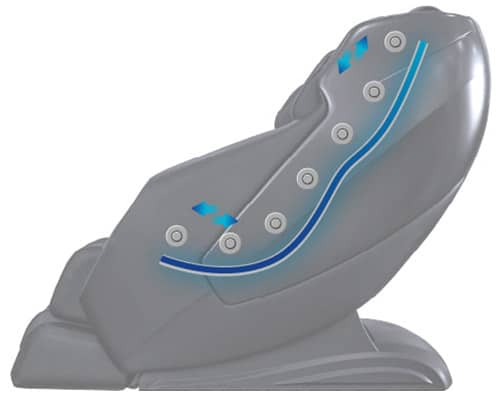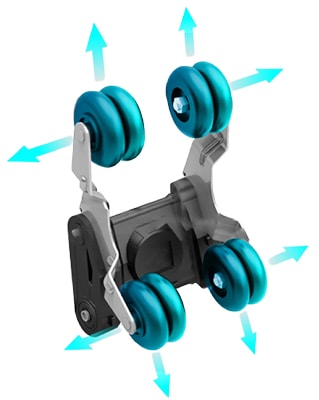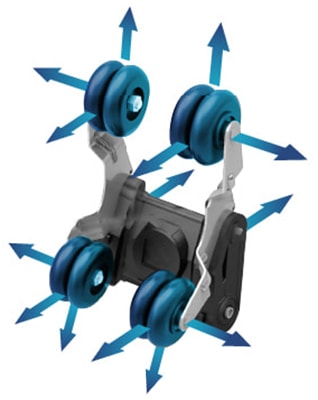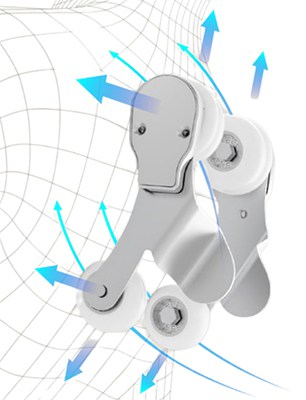Are you diving into the world of massage chairs with excitement, only to feel immediately overwhelmed by all the technical jargon?
These feature-rich recliners give users plenty of versatility to find what works for them- that is if you can narrow it down.
It helps to understand how the different massage rollers work, as each offers unique benefits and experiences. Our 2D vs 3D vs 4D massage chair comparison will show you the way!
An Overview of the Massage Roller System

The massage chair is a technological masterpiece. And, while it may look like a comfy recliner to the untrained eye, underneath that smooth leather exterior is a complex network of gears, motors, and rollers that provide therapeutic relief and relaxation.
Arguably the most important part of a massage chair is its massage track and roller system. This technology makes the magic happen, the automatic moveable parts programmed to deliver quality massage therapy.
The goal of the roller system is to closely mimic the hand movements of a professional masseuse while working smoothly and quietly. There are three main types of rollers that you’ll find on low, mid, and high range chairs: 2D, 3D, and 4D rollers.
Each set of rollers offers its own unique set of benefits and speaks to the quality of the recliner. Understanding the difference between them can help you choose the massage features you want and get the most bang for your buck.
The Massage Track

It wouldn’t be fair to mention massage rollers without the track, as the two go hand-in-hand. The rollers are situated along the track throughout the backrest. They can be fixed, or they move automatically on the track to hit every muscle.
There are three main massage tracks you’ll see on the market as described below:
Now, let’s compare 2D vs 3D vs 4D massage chairs and see how they play in the overall massage experience.
The 2D Massage Chair

If you’re the type of person who doesn’t suffer from back pain and likes to relax after a long day at work, then the 2D massage chair might be your perfect match.
This is the most basic setup that has been around the longest. You’ll typically see 2D rollers on low-range massage chairs, so it’s typically the most affordable type of model.
The rollers move up, down, and side-to-side along the track, applying different massage techniques. The user can adjust the speed and some depth, but 2D rollers lack the deep tissue intensity of 3D and 4D rollers.
This type of system works the surface muscles, helping the user de-stress and feel comfortable in their recliner while watching their favorite TV show.
PROS
CONS
The 3D Roller System

The 3D roller system is the next step up from 2D and is probably what you’ll find in most mid to high-range chairs on the market.
These high-tech rollers not only move up, down, and side-to-side along the track, but they also can move away (in and out) from the track.
This game-changer increases precision and makes it feel like real hands kneading deep into the muscle tissue on the back and shoulders. These flexible rollers can reach hot spots that 2D rollers aren’t capable of hitting with more intensity.
A 3D massage chair provides a better quality massage for frequent users looking for therapeutic benefits. If you suffer from chronic back, shoulder, or neck pain, these rollers are adept at loosening tension, soothing soreness, and facilitating blood flow.
You also get more customization options to choose from, so while one family member prefers a gentle massage, others can fine-tune the intensity settings for something stronger.
Keep in mind that 3D massage chairs are generally more expensive than 2D, but you get added therapeutic value, cutting-edge tech, and customization.
PROS
CONS
The 4D Roller System

You may be wondering how it could get any better than 3D, but 4D rollers are up to the challenge. Granted, you won’t see this type of setup as often as 3D, as it’s a newer technology found on expensive, high-range models.
Once again, the goal of the 4D massage chair is to replicate the hand movements of a masseuse as closely as possible. 4D rollers accomplish this with the same deep tissue capabilities as 3D, except with more speed.
Think about it: when getting a massage, a masseuse doesn’t keep up the same pace while applying various techniques. Their hands slow down or speed up at random moments to stimulate different areas of the body.
That’s the magical effect of 4D rollers. They automatically speed up and slow down throughout the massage, according to the amount of tension in a specific area of the body.
As we said, this is also the most expensive setup out of all three types of rollers, but is it worth it?
Undoubtedly, 4D rollers feel heavenly and offer therapeutic benefits for those who suffer from back pain. If you’re not worried about money and want the top-of-the-line setup, then this is it.
But if you’re on a budget and want to treat back pain, 3D rollers also deliver an exceptional massage experience.
PROS
CONS
Final Thoughts on the Differences Between 2D vs 3D vs 4D Massage Chairs
After comparing 2D vs 3D vs 4D massage chairs, it’s important to consider how much money you want to spend and how often you’ll use the chair when choosing the best one for your needs.
Are you a casual user who just wants to relax? If so, a 2D massage chair will get the job done. If you’re looking for pain relief or want to cut down on chiropractor visits, then look for a 3D or 4D model- it’s worth the investment.
References & Resources:
- S Track Vs. L Track Vs. Sl Track, Kahuna Chair.
- 6 Important Things To Consider Before Buying A Massage Chair!, Human Touch.